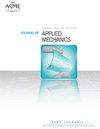软可压缩固体的理论穿刺力学
IF 2.8
4区 工程技术
Q2 MECHANICS
引用次数: 1
摘要
准确预测刺穿柔软材料所需的力在医疗技术、食品加工和制造业等许多领域至关重要。然而,这样的预测很大程度上取决于我们对材料在深压痕和复杂破坏机制下的复杂非线性行为的理解。直到最近,我们才发展出能够将穿刺力与材料特性和针的几何形状联系起来的理论。然而,这些模型是基于简化的,很少限制它们对实际案例的适用性。一个常见的假设是切割材料的不可压缩性,尽管没有材料是真正不可压缩的。在本文中,我们提出了一个简单的模型来解释线弹性压缩性,以及它与韧性、刚度和弹性应变硬化的相互作用。证实先前的理论和实验,具有高韧性和低模量的材料在给定的针半径下表现出最高的穿刺阻力。令人惊讶的是,在这些条件下,我们观察到不可压缩材料表现出最低的穿刺阻力,其中体积可压缩性可以为穿刺创造额外的(应变)能量屏障。我们的模型为评估柔软可压缩材料的抗穿刺性提供了有价值的工具,并为尖锐针头和抗穿刺材料的设计提供了新的策略。本文章由计算机程序翻译,如有差异,请以英文原文为准。
Theoretical Puncture Mechanics of Soft Compressible Solids
Accurate prediction of the force required to puncture a soft material is critical in many fields like medical technology, food processing, and manufacturing. However, such a prediction strongly depends on our understanding of the complex nonlinear behavior of the material subject to deep indentation and complex failure mechanisms. Only recently we developed theories capable of correlating puncture force with material properties and needle geometry. However, such models are based on simplifications that seldom limit their applicability to real cases. One common assumption is the incompressibility of the cut material, albeit no material is truly incompressible. In this paper we propose a simple model that accounts for linearly elastic compressibility, and its interplay with toughness, stiffness, and elastic strain-stiffening. Confirming previous theories and experiments, materials having high-toughness and low-modulus exhibit the highest puncture resistance at a given needle radius. Surprisingly, in these conditions, we observe that incompressible materials exhibit the lowest puncture resistance, where volumetric compressibility can create an additional (strain) energy barrier to puncture. Our model provides a valuable tool to assess the puncture resistance of soft compressible materials and suggests new design strategies for sharp needles and puncture-resistant materials.
求助全文
通过发布文献求助,成功后即可免费获取论文全文。
去求助
来源期刊
CiteScore
4.80
自引率
3.80%
发文量
95
审稿时长
5.8 months
期刊介绍:
All areas of theoretical and applied mechanics including, but not limited to: Aerodynamics; Aeroelasticity; Biomechanics; Boundary layers; Composite materials; Computational mechanics; Constitutive modeling of materials; Dynamics; Elasticity; Experimental mechanics; Flow and fracture; Heat transport in fluid flows; Hydraulics; Impact; Internal flow; Mechanical properties of materials; Mechanics of shocks; Micromechanics; Nanomechanics; Plasticity; Stress analysis; Structures; Thermodynamics of materials and in flowing fluids; Thermo-mechanics; Turbulence; Vibration; Wave propagation

 求助内容:
求助内容: 应助结果提醒方式:
应助结果提醒方式:


